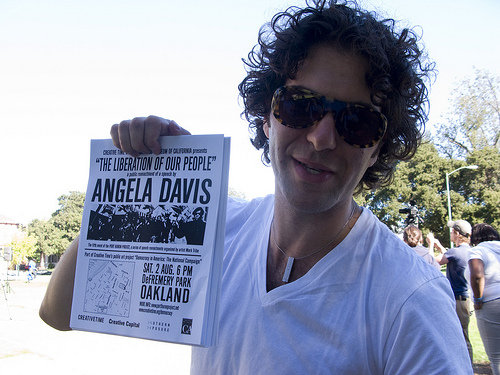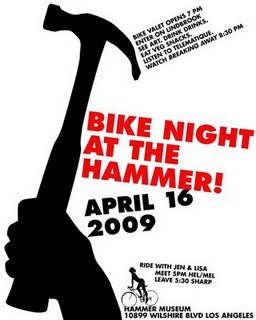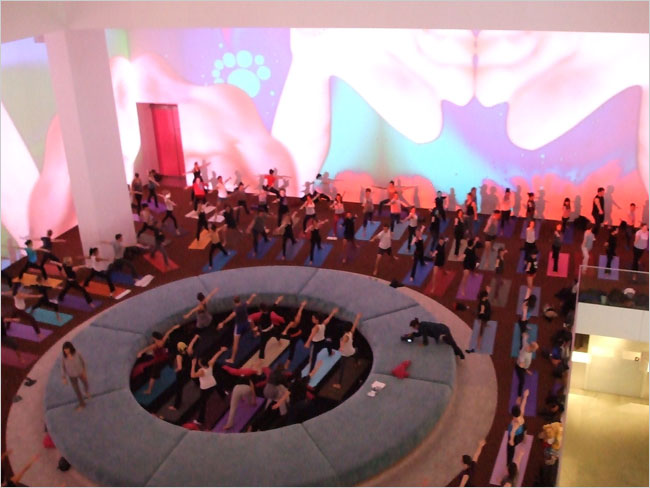By Adam Rozan

The author at the Oakland Museum of California, showcasing and Creative Time presents Mark Tribe's Port Huron Project 5: The Liberation of our People.
The Targeting Young Cosmopolitans in Museums study was born out of a 2009 session of the Association of Midwest Museums conference entitled, The Next Generation: Targeting Young Audiences in an Uncertain Economic Climate.
The report was designed to measure the energies involved in young cosmopolitan programming by examining 170 museums, varying in size, affluence and scope.
The term “young cosmopolitan” describes a hybrid generation born out of Generation X (those born between 1967 and 1977) and Generation Y (those born between 1978 and 1993). They “are exceptionally social, ethnically diverse, college educated, technologically savvy, and have a creative and open mindset.” Alexandra Gregg, co-author of the Targeting Young Cosmopolitans in Museums survey, wrote earlier in a post on WestMuse:
YoCo – young cosmopolitan – because it focuses more on a psychographic than on specifically drawn lines of age, gender, etc. YoCos are the people who are highly social, are all over Facebook and iPhones, and are curious, creative, and cosmopolitan. It’s the people who go to the Hirshhorn’s famous after-hours event in DC, or the Hammer’s Bike Night in LA… But YoCos can still be understood in terms of geography and economics – they tend to gravitate around cities and have a general US buying power of $924 billion.
A recent cover from Time Out New York reads, “You’re smart. Cultured. And you’ve never been to the Rubin?... Museums: The Actually Cool Guide.” Inside the article reads as a tasting menu of New York city’s many museums, highlighting various activities, events and parties held each month targeting this cosmopolitan audience.
Despite such articles, this scene is not the norm across the country, rather the opposite--only 37% of museums that participated in the Targeting Young Cosmopolitans in Museums study offer such programs.
 With the key attributes of the YoCos in mind (e.g. highly social, college educated, creative, etc.), why are the other 63% of museums studied in this survey not engaging these audiences? Funding, limited staff time, lack of board support, and “not enough time to organize an effective program to YoCos,” prevailed as the primary reasons provided. Furthermore, 8% of those surveyed felt “this demographic cannot be reached” and accordingly another seven museums provided that this target group was not relevant to their institution. While seven museums are far from a majority, can any institution truly afford to ignore this diverse and knowledgeable audience?
With the key attributes of the YoCos in mind (e.g. highly social, college educated, creative, etc.), why are the other 63% of museums studied in this survey not engaging these audiences? Funding, limited staff time, lack of board support, and “not enough time to organize an effective program to YoCos,” prevailed as the primary reasons provided. Furthermore, 8% of those surveyed felt “this demographic cannot be reached” and accordingly another seven museums provided that this target group was not relevant to their institution. While seven museums are far from a majority, can any institution truly afford to ignore this diverse and knowledgeable audience?
YoCo programming remained the primary responsibility of the education and programming departments for 51% of the study, and sadly, only 7 museums reported “cross-departmental collaboration (primarily between education and marketing),” and only one institution had a “YoCo team with representatives from marketing, events, development, etc.”
The 77% of museums that host YoCo programs reported having clear goals and objectives, and used terms like “attract,” “welcome,” “target,” “reach,” or “increase attendance” to describe some of their goals; another group used “engage” or “educate” to best describe their objectives. Because only 23% of respondents “have or consult a young adult advisory board or related committee,” it is not surprising that some of the museums felt they were not adequately targeting the YoCo audience.
What is to be done with YoCos?
Time Out New York’s article on museums highlights activities such as “behind the scenes tours, lectures, films, and even the quirky B-movie nights,” which are similar to those mentioned by the museums surveyed. These events usually occur at night and are aimed at attracting YoCos to museums. The evenings differ between alcohol and no alcohol, tours to lectures, and so as I have written earlier here at WestMuse:
At first, with young adults the need was to create the parties, and provide the invitation. Now, that they are arriving, and are interested–isn’t this the time to change our programs, exhibitions, and other existing models of activity? Let’s begin to re-think how visitors act and interact inside galleries, and with our collections. Asking what is the role and purpose of exhibitions, and programs, and how our visitors are to use them and participate. Maybe the best place for the deejay is inside the gallery, on a Saturday afternoon, next to the collections?
Rethinking our visitors and the visitor experience is paramount to the successful museum, not just in outreach exercises, but in the delivery of the modern museum visit. What that means is unique to each museum: however, we can no longer avoid the new rules assumed by today’s modern audiences. The lives of YoCos are defined by their digital identities and social and cultural connections with their psychographic interests. The balance between one’s iPhone and one’s personal life has merged, and yet at the same time the need to socialize, learn, and interact has never been more present.

Museum of Modern Art Twitter Sign in to Recommend STRETCH A yoga class at MoMA surrounded by a video installation by the Swiss artist Pipilotti Rist.
In many ways we are entering an era focused on experiences. In the 2009 Museum Section of the New York Times, Carol Vogel writes:
Yoga classes and bicycle get-togethers may not be your typical museum fare, but in these rough economic times, anything goes…But lean times are bringing out a pioneering spirit as museum officials strive to develop creative strategies for what is undeniably a new world… Most, if not all are expanding their public program. More than before, institutions big and small have adopted the same mission: to transform once-hushed museums into vibrant cultural centers where the activities go far beyond what’s hanging on the walls.
Today’s economy has given permission to experiment, and has required us to evolve. Audience development for museums is not by any means a new pursuit, nor is recognizing underserved audiences within our institutions. Moving away from demographic pursuits to psychographics and augmenting our institutions to today’s audiences is necessary to captivate today’s audience and tomorrow’s patrons.
(Note: Special thanks to Kathleen McNally for her assistance with this article!)








Comments
great post, Adam! I'd love to hear more about how the survey results impact, and looking forward to seeing more folks chime in...
I'm doing a session at #wma09 in a couple of weeks in San Diego about on-line engagement and metrics. this seems to be a big part of all this, too.
Games are showing a lot of promise and John Maccabbee of CityMystery is part of my session. He did Ghost of a Chance for the Smithsonian
http://americanart.si.edu/calendar/activities
http://museumtwo.blogspot.com/2008/09/arg-at-smithsonian-games-collectio...
thanks for the article. i am going to share this with my YoCos staff.
Great article. Maybe it is time to rethink how exhibitions and programs should flow together in the minds of visitors.
Delightful article! As a Masters student investigating the Material Culture & History of Fashion I'm finding many connections to the Cosmopolitan appreciation of the visual and performing arts and the birth of Haute Couture. I think you've certainly got something here. Thanks for sharing!
Add new comment